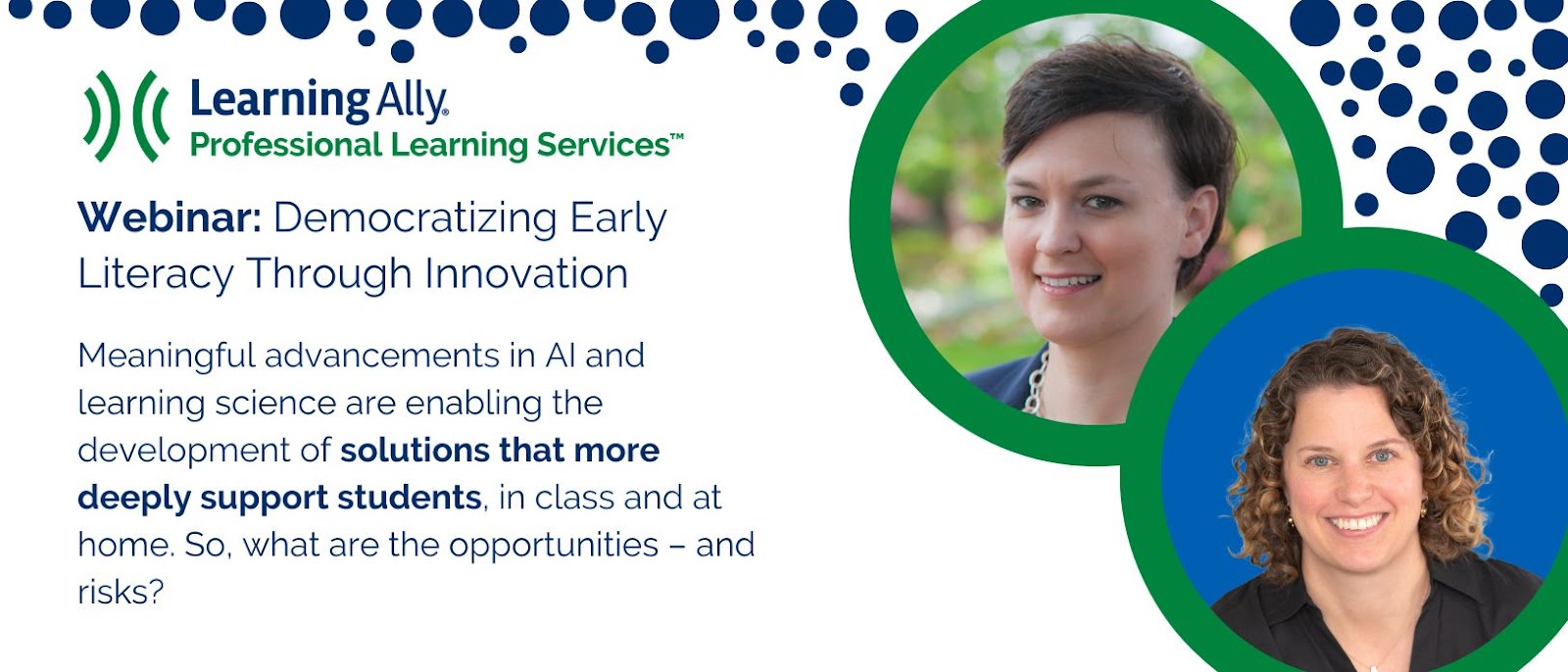This blog recaps a webinar by Learning Ally’s Heather Wiederstein and Dr. Molly Ness, former educators and literacy leaders in education technology. Wiederstein, a software developer, and Ness, V.P. of Academic Content, engaged an insightful audience eager to learn the latest research of “how” students learn to read, and some beneficial ways emerging technologies can add value to early literacy development. Listen now to earn CE certificates by gaining new insight into how technologies create more learning opportunities for educators, students, and families, and by using guiding principles to choose technology wisely. This will ensure ALL children learn to read in an equitable learning environment.

Why Technology?
Innovative educators understand that the selective use of devices, apps, video, digital textbooks, ebooks, artificial intelligence, 3D printing, text-to-speech, and so much more can add value to their instruction. When we democratize early literacy, we consider a larger ecosystem of democratic principles and intention to make early literacy accessible and beneficial for all students. This system makes literacy a priority in ALL classrooms. ALL educators are knowledgeable in evidence-based instruction grounded in the science of reading. ALL emerging readers are taught using a Whole Child Literacy approach, taking into account their social, emotional and academic circumstances.
Early Literacy is the Right Time
Weiderstein and Ness agree that children must be taught to read as early as PreK using both phonics instruction and language development, and that technology enhances instructional opportunities for literacy.
An example of using technology to teach phonics is to integrate supportive videos that display images, or use multisensory auditory apps that render correct pronunciation of phonemes (a visual representation to see the mouth form words), or introducing an educational game that reinforces specific skill sets.
To enhance reading comprehension, early educators might consider Excite Reading™, a supplemental PreK-2 program that takes emergent readers on visually stimulating early learning journeys with engaging, culturally-relevant collections of stories in the form of e-books narrated by humans to strengthen children’s agency of knowledge.
Guiding Principles to Choose Education Technology Wisely
Wiederstein says, “Technology never replaces the educator, but by adding the right technology, teachers can become innovators and literacy leaders. These champions move the needle on equity and access because they balance their high quality reading instruction based on the research, with technology that can individualize, customize, and democratize the learning environment.
As you evaluate and purchase education technology, ask if the technology will:
-
Strengthen a ‘child-focused’ learning environment, such as using culturally-rich content?
-
Increase interactions and conversations to build better relationships?
-
Encourage reading practice, word study, vocabulary building, and background knowledge?
-
Provide access to content that is available outside the school walls?
Scaling Impact for Improved Reading Outcomes
In the wake of the pandemic, nearly a third of all children in early grades, especially those disproportionately from under-resourced communities, are missing early reading benchmarks.
“Recent NAEP scores remind us we’ve got a way to go,” says Dr. Ness, “especially with respect to reading, equity, and access. Student achievement is what matters most. The reality is teachers are tapped thin, and there are more diverse populations with reading challenges. If a child doesn’t have books at home and does not live near a library or have Internet, we’re failing them.” Read Dr. Ness’s blog, “10 Ways to End Book Deserts.”
What We Know About Literacy Today
Education is lagging behind almost all industries that benefit from technology. Adding quality technology can help educators level the learning field by amplifying opportunities to engage and interact with one or many children at once. Dr. Ness recommends doubling down on the evidence-based research that is now readily available and verifiable in study after study.
“The NAEP report is a motivator that we all need to look for innovative ways to get more kids reading,” says Ness. “Today, there’s a real urgency to grow our professional knowledge based on reading research, and technology can help us do that.”
Wiederstein says, "Choosing technology wisely can help educators balance instruction, broaden capacity, provide individualized instruction and equitable access, and strengthen relationships.
Dr. Ness says, “It takes about a decade for research to have an impact on actual daily instructional practice." She also cautions us that there are still educators and parents who believe using technology is somehow cheating, but we know that is not true.
Everyone must swing in the same direction regarding effective reading instruction. If we miss the mark, children will continue to struggle.
Literacy leaders must address politicization, and polarization of how to teach reading successfully, and commit to ongoing professional learning on the science of reading and brain-based learning.
Learning Ally’s reading Solutions, spotlight learning series and professional courseware can help you make an impact on reading outcomes for all learners.
Whether you use technology in your classroom, or have students use it on the go, in the library, or at home, the right technology can be a pivotal tool to accomplish varying education learning goals.
About the Presenters:
Heather Weiderstein began her career in education as a certified classroom teacher in Pennsylvania. She taught reading, English Language Arts, and Literature and Composition. She has dedicated the last 15 years to writing, designing, and managing the delivery of learner-focused educational software. Today, she is a Senior Advisor for Learning Ally, and in this role, Heather strives to bring our partners the highest quality, easy-to-use technology solutions.
Dr. Molly Ness is the Vice President, Academic Content for Learning Ally. She is a former classroom teacher, reading researcher, and teacher educator. She holds a doctorate in reading education from the University of Virginia and spent 16 years as an associate professor at Fordham University. With four books and numerous peer-reviewed articles, Molly’s research focuses on reading comprehension, teachers’ instructional decisions, and dyslexia. In 2019, she began the End Book Deserts podcast to bring attention to the issue of book access and equity. Molly serves on the Board of Directors for the International Literacy Association and on the elementary advisory panel for Penguin Random House.